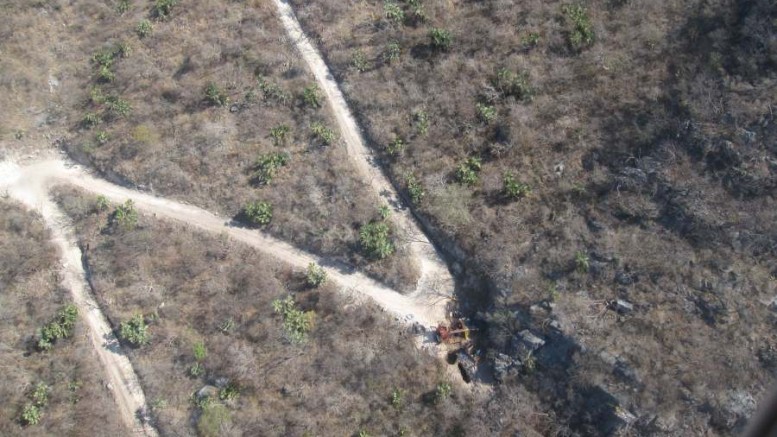Torex Gold Resources (TXG-T) shares saw heavy trading after the company released a bankable feasibility study for its Morelos project in Mexico’s prolific Guerrero gold belt, as well as more drill results from the project’s Media Luna exploration target.
The stock closed Sept. 5 — the day after the announcements were made — down 4% at $1.73, on 8.1 million shares traded.
The study envisions developing two individual open pits to mine the skarn-hosted gold and silver mineralization. The pits would feed a central cyanide-leach or carbon-in-pulp plant at a rate of 14,000 tonnes of ore per day.
Torex plans to kick off mining in 2015, with commercial production starting in October of that year. The pits would take two years to ramp up to 14,000 tonnes per day, with 2017 marking the first full year of production, the company’s president and CEO Fred Stanford said on a conference call.
“This slow ramp-up is a function of access to get to the top of the mines to start the stripping, and to get down to the level were we can extract that much ore in order to achieve full production,” Stanford said.
Morelos is slated to operate at the full rate for the following eight and a half years, before experiencing a drop in output during its last four years, a period that Stanford calls the production tail.
For the first 10 years of the mine’s life, annual output would average 337,000 oz. gold and 211,000 oz. silver. Cash costs net of silver revenue — excluding the production tail — are pegged at US$421 per oz. gold.
The feasibility study estimates higher production and lower costs at Morelos that are offset slightly by higher capital requirements, BMO Capital Market’s analyst Andrew Breichmanas observes in a note.
Torex forecasts it would cost US$675 million to take the proposed mine to commercial production. But when including the estimated revenue credits of US$123 million from pre-commercial ounces, that amount drops to US$552 million. The project should require another US$86 million in capital expenditures, including US$23 million in sustaining capital.
The company’s CEO attributes the low sustaining capital to the company’s new fleet of equipment, new mill and dry-stack tailings.
“We don’t have underground mine capex, we have a brand new mill. We have not bought a used fleet of equipment that needs to be replaced prematurely, so we don’t really have a lot of sustaining capex planned, except for replacing some of the mine fleet that wears out over the ten-year mine life. That is why the number is lower than some might expect.”
The mine should reach commercial production once the mill is operating at 60% of its full capacity for one month, Stanford said, adding that this should be achieved by October 2015.
On an after-tax basis, Morelos has a present net value of US$900 million and an internal rate of return of 24.2%, using a 5% discount rate and a life-of-mine gold price of US$1,276 per oz. Cumulative cash flow is forecast to be US$1.5 billion.
Torex anticipates recouping Morelos’ total costs in less than four years.
The project’s El Limon and Guajes deposits host reserves of 4.1 million oz. gold and 6.8 million oz. silver, from 48.8 million tonnes grading 2.61 grams gold and 4.35 grams silver per tonne.
“BMO Research considers Morelos to be one of the premier development projects in the gold sector due to its relatively high-grade resource, meaningful production scale, robust economics and attractive location,” Breichmanas comments. He has introduced a $2.50 target price and rates the stock “outperform speculative.”
On the exploration front, Torex has released five more holes from drilling at the Media Luna discovery, located south of the Balas River, where it continues to intersect gold-copper-silver mineralization.
Standout intercepts include 15.4 metres grading 5.65 grams gold per tonne, 43.80 grams silver and 1.25% copper in hole 4, and 43.9 metres of 0.65 gram gold, 66.71 grams silver and 2% copper in hole 46a.
The ongoing exploration may provide more ore feed for the proposed Morelos mill, Breichmanas notes.
Torex has nine drills turning on site, with five at Media Luna, two at the Media Luna West magnetic anomaly and two conducting stratigraphic drilling.
Construction at Morelos should start next year, Stanford says, adding that the company has sufficient cash.
After market close on Sept. 5, Torex posted its third-quarter results ending July 31, 2012.
It reported a net a loss of $15.1 million, compared to a loss of $7.3 million a year ago.
Exploration and evaluation expenditures totalled $13.2 million, which is more than double the amount spent a year earlier.
The company’s cash position increased to $69.2 million, up from $36.3 million in the same period last year.


Be the first to comment on "Torex plans 2015 start-up for Morelos"